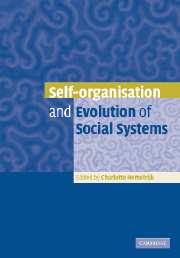Book contents
- Frontmatter
- Contents
- List of contributors
- Preface
- Introduction
- 1 From unicellular to multicellular organisation in the social amoeba Dictyostelium discoideum
- 2 Optimality of communication in self-organised social behaviour
- 3 The interplay of intracolonial genotypic variance and self-organisation of dominance hierarchies in honeybees
- 4 Traffic rules of fish schools: a review of agent-based approaches
- 5 A process-oriented approach to the social behaviour of primates
- 6 Order and noise in primate societies
- 7 Self-organisation in language
- 8 Dictatorship effect of majority rule in voting in hierarchical systems
- 9 Natural selection and complex systems: a complex interaction
- 10 Interlocking of self-organisation and evolution
- Index
- References
9 - Natural selection and complex systems: a complex interaction
Published online by Cambridge University Press: 07 December 2009
- Frontmatter
- Contents
- List of contributors
- Preface
- Introduction
- 1 From unicellular to multicellular organisation in the social amoeba Dictyostelium discoideum
- 2 Optimality of communication in self-organised social behaviour
- 3 The interplay of intracolonial genotypic variance and self-organisation of dominance hierarchies in honeybees
- 4 Traffic rules of fish schools: a review of agent-based approaches
- 5 A process-oriented approach to the social behaviour of primates
- 6 Order and noise in primate societies
- 7 Self-organisation in language
- 8 Dictatorship effect of majority rule in voting in hierarchical systems
- 9 Natural selection and complex systems: a complex interaction
- 10 Interlocking of self-organisation and evolution
- Index
- References
Summary
In their book Darwinism Evolving, Depew and Weber (1995) develop the thesis that evolutionary theory has been reformulated several times to keep pace with advances in knowledge about the physical world. Darwin's Newtonian formulation was replaced by a probabilistic formulation early in the twentieth century. According to Depew and Weber, the new science of complexity will force yet another formulation, which is taking place during our time.
This general thesis may well be correct but Depew and Weber's specific account of the relationship between evolution and complexity leaves much to be desired (Wilson, 1995). They largely accept the polemic view of Gould and Lewontin (1979) at face value, arguing that natural selection is far more constrained and adaptations less common than claimed by proponents of the so-called adaptationist programme. Complexity is viewed as something that stamps its own properties on organisms and resists the modifying effects of natural selection.
Depew and Weber are not alone in this view. Many complexity theorists and writers seem to parade under the banner ‘Darwin is dead! Long live complexity!’ The following passage by Kauffman (1993: 24) provides one example:
In short, if selection is operating on systems with strongly self-organized properties that are typical of the ensemble being explored, then those properties simultaneously are the proper null hypothesis concerning what we would expect to find in the absence of selection and may be good predictors of what we will observe even in the presence of continuing selection. In brief, if selection can only slightly displace evolutionary systems from the generic properties of the underlying ensembles, those properties will be widespread in organisms not because of selection, but despite it.
- Type
- Chapter
- Information
- Self-Organisation and Evolution of Biological and Social Systems , pp. 151 - 165Publisher: Cambridge University PressPrint publication year: 2005
References
- 5
- Cited by



